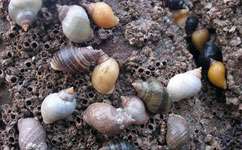Research sheds new light on pollution and sex-change whelks

Scientists have found an entirely new genetic route by which a now-banned chemical causes sexual and hormonal disruption in a marine mollusc.
From the 1960s onwards, tributyltin (TBT) was widely used in paints to keep ship hulls free of organisms like seaweed, barnacles and molluscs, which cause drag and slow progress through the water. But it was banned by the International Maritime Organisation after scientists discovered it was causing havoc with shellfish populations.
In particular it causes female gastropods - snails - to grow male genitals. This is known as imposex, and can devastate affected populations by stopping females from breeding.
The findings increase our knowledge of the complex ways in which pollution affects wildlife. Since the ban TBT levels have been falling around Europe, and affected marine populations are recovering. Yet even in well-regulated waters, TBT is still found in sediments where it can be disturbed and return to the environment, so it's still important to understand how it acts on living things.
Dogwhelks are particularly vulnerable to TBT, so they're considered the standard sentinel species to provide early warning of its presence. It's thought TBT can also damage the health of a much wider range of animals, though - for example, it causes malformation in oysters and has been linked to harm to mammals like dolphins and sea otters.
Sonia Pascoal, a PhD student from Bangor and Aveiro Universities, and colleagues used gene sequencing to find out which genes are expressed in a dogwhelk's tissues at different times after exposure to TBT. They then immobilized around 180,000 snapshots of this gene activity on so-called microarrays, and used these to find out exactly which genes were responding to the presence of TBT.
There were already three hypotheses about how TBT might be causing imposex in dogwhelks. The 'steroid hypothesis' suggests that TBT inhibits enzymes that metabolise steroids, increasing female whelks' testosterone levels. The 'neuroendocrine' hypothesis proposes that TBT acts as a neurotoxin, causing excessive secretion of hormones that control sex differences. And the 'retinoid hypothesis' holds that the chemical disrupts the function of particular signalling pathways in whelks' endocrine systems that depend on the chemical retinoic acid.
The gene analysis found all three were happening, as well as a previously-unknown fourth. 'We could see that all the hypotheses people have talked about before were in action, but we could also see another one - the PPAR pathway,' says Dr Pascoal, now at the University of St Andrews. This pathway was already known to be important in vertebrates (the group of animals with backbones, including fish, birds and mammals), but this is the first indication that it has a significant role in molluscs. 'We found surprising commonalities between vertebrates and invertebrate molluscs in this area of endocrine disruption,' adds Dr Simon Creer, the senior author on the paper. 'Our hypothesis is that TBT is emulating the effect of PPAR, activating the pathway to cause the growth of a penis in females.'
It's still too early to say exactly which of the hypotheses is primarily responsible for imposex - it's likely several of them play a role. 'We don't know whether they act alone or in combination,' Creer explains. 'At the moment we only know that this is another pathway that's involved. To find out more we'll need to do a lot more work, such as subjecting the organisms to TBT with particular genes knocked out to see if imposex still happens.' He says it would also be a good idea to look at TBT's effects on a wider range of organisms.
The work was made possible by recent developments in post-genomic techniques that provide much more capability alongside a 40-fold reduction in costs, and an ability to sequence large amounts of the DNA of species that have not been intensively studied from a genetic perspective. The NERC Biomolecular Analysis Facility (NBAF) at the University of Liverpool provided the DNA sequencing of gene readouts, the construction of the microarray devices, testing of tissue samples from dog whelks exposed to different conditions and bioinformatic support. Funding came from a small NBAF grant and a studentship from the Fundação para a Ciência e a Tecnologia in Portugal.
The paper appears in Molecular Ecology.
Journal information: Molecular Ecology
Provided by PlanetEarth Online
This story is republished courtesy of Planet Earth online, a free, companion website to the award-winning magazine Planet Earth published and funded by the Natural Environment Research Council (NERC).















